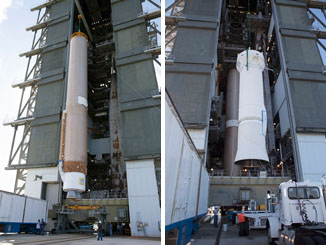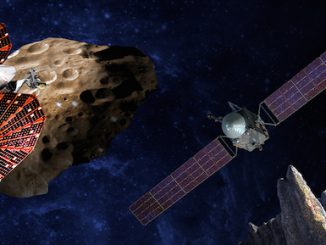
The bronze first stage of United Launch Alliance’s next Atlas 5 rocket arrived at its Cape Canaveral launch pad Friday, where it will be joined by five solid-fueled boosters, a Centaur upper stage and a U.S. Air Force communications satellite in the coming weeks ahead of liftoff set for June 27.
Riding on a specially-outfitted trailer, the rocket’s first stage was trucked from the Atlas Space Operations Center at Cape Canaveral Air Force Station to the nearby Complex 41 launch pad, where cranes lifted the 107-foot-long (32-meter) stage vertical and placed it on a mobile platform inside the Vertical Integration Facility.
ULA workers will next install five strap-on solid rocket boosters, manufactured by Aerojet Rocketdyne, around the base of the Atlas 5’s first stage. A Centaur upper stage will be hoisted atop the Atlas 5, and the rocket’s build-up at Cape Canaveral will be capped with the addition of the Air Force’s fifth Advanced Extremely High Frequency communications satellite next month.
The AEHF 5 satellite will be the sole payload on the Atlas 5 rocket when it lifts off from Florida’s Space Coast.
The launch is scheduled for June 27 during a two-hour window that opens at 6 a.m. EDT (1000 GMT).
The Atlas 5, designated AV-083, will launch in its most powerful variant with five strap-on solid rocket boosters built by Aerojet Rocketdyne and a 5-meter-diameter (17.7-foot) payload fairing made by Ruag Space, a configuration known as the Atlas 5-551 that has flown nine times before. The five solid-fueled motors will provide an extra boost to the Atlas 5’s first stage, powered by a Russian-made RD-180 main engine that burns kerosene and liquid oxygen propellants.
The combined power of the boosters and main engine will give the Atlas 5 around 2.6 million pounds of thrust at liftoff.
The June 27 launch will mark the first Atlas 5 flight of the year, and the 80th Atlas 5 launch since the rocket debuted in August 2002. It will be ULA’s third mission of 2019, following two Delta 4 launches earlier in the year.
Built by Lockheed Martin, the AEHF satellites provide secure communications services to the U.S. military, working together in a network the Air Force says is resilient to jamming, cyber attacks, and even nuclear war. The AEHF spacecraft are positioned in geostationary orbit more than 22,000 miles (nearly 36,000 kilometers) over the equator, using a cross-linked architecture allowing the satellites to relay signals between one another without transmitting to ground stations.
The AEHF 5 satellite’s launch comes after the launch of four previous AEHF spacecraft in 2010, 2012, 2013 and 2018, all on Atlas 5 rockets.
Once the Atlas 5 rocket carrying the AEHF 5 satellite blasts off from Cape Canaveral, the launch campaign for the following Atlas 5 mission will begin in July with the stacking of a new rocket assigned to send Boeing’s CST-100 Starliner crew capsule into orbit on an unpiloted test flight to the International Space Station.
The Starliner’s test flight is scheduled for liftoff no earlier than Aug. 17, and the demonstration mission will pave the way for crewed launches using the Atlas 5 rocket and Starliner capsule, perhaps as soon as late this year.
Email the author.
Follow Stephen Clark on Twitter: @StephenClark1.



